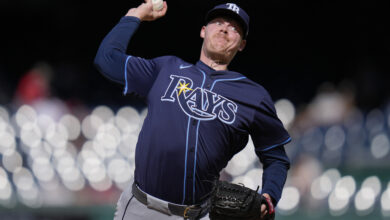
Factors Driving Brewers’ 77-Win Projection Are Same Saying They Might Win More
FanGraphs projects the Cubs to win 92 games in 2018, while the Brewers are expected to only win 77 games. That total seems awfully low considering they just came off of an 86-win season and acquired two big-time outfielders in Christian Yelich and Lorenzo Cain.
There’s a sentiment I’ve heard frequently since the acquisitions were made that goes something like this: Even though the Brewers got two good outfielders, they still have ways to go because they are only projected to win 77 games. And that isn’t necessarily untrue, it’s just that win totals are extremely difficult to model, particularly when you’re talking about such seismic changes to a roster.
Sure, Milwaukee’s sub .500 projection is a little funny — and even encouraging — but the team playing at Wrigley North is probably better than it looks. For more on that, let’s look at a general explanation of how projection systems work.
A nerd puts a player’s recent season statistics into a computer. He or she asks the question, “Hmm, how similar or dissimilar was that player’s performance over several seasons?” They pull out a number that describes this similarity, which is used to create an estimate for the following season. But they aren’t done yet. The next stop is to try to find similar historical players to see how they progressed or deteriorated. After pushing their taped-up glasses back into place and adjusting their pocket protectors, the nerds factor in age.
Badda bing, badda boom, out pops a projection.
So if a team was pretty bad one season, didn’t add players with good track records for the following season, yet suddenly became really good *cough* Brewers *cough*, the nerds won’t discount that poor performance when projecting the future.
It’s this season-to-season dissimilarity among Brewers’ players that’s driving their lowly 77-win projection. But it’s also this uncertainty that makes nerds skeptical that the Brewers will actually only win 77 games.
All players’ careers into account. That means Jonathan Villar’s -0.5 fWAR season last year isn’t forgotten, nor is his 3.1 fWAR season from 2016. Also under consideration is Travis Shaw’s 89 wRC+ in 2016, even though he hit to the tune of a 119 wRC+ last year. Then there’s Chase Anderson’s 5.09 FIP from 2016, which computers hate, and his 3.58 FIP last year, which computers do not hate. Does a computer like Brent Suter, who had a sub-4 FIP in 2017? Nope. They remember Suter as a 27-year-old AAA pitcher struggling to make it.
It’s this season-to-season dissimilarity among Brewers’ players that’s driving their lowly 77-win projection. But it’s this same uncertainty that has created healthy skepticism that the Brewers will really only win 77 games.
When comparing FanGraph’s 2017 team win projections to how many wins a team actually won, we can begin to appreciate the beautiful nature of baseball’s entropy. A standard deviation was plus or minus almost 6 wins in 2017. Twenty MLB teams fell beneath this umbrella of + 6 wins, and the remaining 10 or so squads were even harder to predict. In fact, FanGraphs’ win projections only captured 25 percent of what actually goes into a team’s season win total.
This isn’t an indictment of FanGraph’s computers, not at all. This is more a lesson on what goes into these forecasts and a cautionary tale for those who’d take a sub-.500 projection as gospel.
Yes, the smartest baseball nerds on the planet are projecting the Brewers to win 77 games, but they are skeptical of their own results because they understand how their computers work. The Brewers can win more than 85 games, and the fact they did so last year is always in the back of those hard drives. It’s in the back of my mind, too.
And if Milwaukee is indeed able to add another starter, the potential for a much higher win total is going to find itself front and center.

